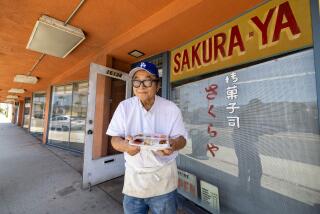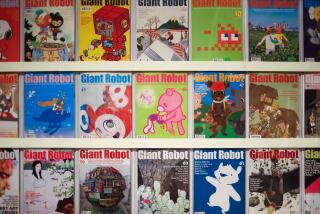Saving Art by the Sheet
- Share via
Before Hiromi Katayama became the primary supplier of imported Japanese conservation papers to the Getty Center, Los Angeles County Museum of Art and other major U.S. museums, she had to find faith. Faith Zieske, that is, a conservator at the Philadelphia Museum of Art.
With Katayama translating for Zieske in discussions with venerable Japanese papermaker Kozo Furuta, the team saved two of the museum’s damaged Cezanne sketchbooks, choosing a delicate, lighter-than-air washi (Japanese for paper) that, after being dipped in water, would blend into the existing paper, allowing the drawings to bleed through.
“I was a mixed-media artist influenced by the avant-garde Japanese art group Gutai,” says Katayama, a diminutive, no-nonsense woman married to L.A. painter Joe Goode. “I wanted to experiment with handmade paper and metal and convinced Mr. Furuta to take me on. He did not want to help me at first because he did not accept my artwork. But I was young and attractive, so eventually he taught me.”
Katayama learned to distinguish subtle differences in the fragile characteristics of various Japanese shrubs used in the papermaking process--such as the kozo shrub, with crisscross fibers that provide strength and durability. She abandoned her art career to bring rare papers to the United States for use by artists and museums.
Although papermaking dates to AD 105, paper conservation is a relatively new field. “There are Western papers that can be used, but the Japanese papers are, by far, the best,” says Mary Reinsch-Sackett, head of conservation at the Getty Research Institute Library, who turns to Katayama for tosa tengujo, a virtually transparent paper used to repair torn edges of centuries-old art, such as a Jacques- Louis David sketchbook. “Hiromi’s contacts in the field is invaluable to us.”
“Hiromi puts us into direct contact with many of the old Japanese papermakers, most of whom are national living treasures,” says Victoria Blyth-Hill, LACMA’s conservation center head, who calls Katayama “a great asset to the field of paper conservation.”
Hundreds of textured and colored paper samples line the walls of Hiromi Paper International’s Bergamot Station showroom, from an 80-cent sheet of masa (smooth on one side, coarse on the other) to a $480 roll of crown paper (for printmaking). Perhaps as a backlash to all things cyber, handmade papers are enjoying a resurgence, says Katayama, who now also sells to the public. “You can even sew some of this paper,” she says, smoothing a crease in a lacy pale blue sheet as if feeling it for the first time.
“Mr. Furuta died five years ago,” she says sadly, “and many of the masters are quite old. Unless younger students learn the process, all of this will be lost.”
*
Hiromi Paper International, Bergamot Station, 2525 Michigan Ave., Santa Monica; (310) 998-0098.
More to Read
The biggest entertainment stories
Get our big stories about Hollywood, film, television, music, arts, culture and more right in your inbox as soon as they publish.
You may occasionally receive promotional content from the Los Angeles Times.










